What you measure improves
One of the businesses I used to own was a Fit Body Bootcamp franchise. Our goal in the business was to help our members lose body fat and get in the best shape of their lives.
We had a lot of success with this goal and it was incredible to witness these physical transformations. To help members achieve their fat loss goals, I would setup weekly one-on-one assessments to measure:
1. body weight
2. inches lost (We would measure inches for their chest, arms, waist, hips, and legs)
3. changes in their body fat percentage
These three measurements showed us the progress they were making towards their fat loss goals. If someone didn’t make progress from their previous weekly assessment, I would suggest a minor change in their nutrition plan. We would then measure how this minor change impacted their next assessment. Overtime this system produced incredible results and these results were driven from the weekly measurements.
As you might imagine, the members who didn’t schedule weekly assessments, didn’t seem to make the same progress towards their fat loss goals.
Measurement forces us to pay attention and what we pay attention to improves. Measurement forces us to make choices based on what we’re measuring. Measurement forces accountability.
This was extremely interesting to observe and these observations have the ability to change other areas of our lives. Let’s consider the goal of financial freedom. For our purposes, financial freedom will be achieved when our monthly recurring investment income equals our monthly living expenses.
Why not set a goal for our monthly investment income and measure our progress?
As an example, what would happen if you set a goal to increase your monthly recurring investment income by a certain amount each month? How about $200 a month? What would hitting this goal look like?
Month One: $200
Month Two: $400
Month Three: $600
Month Four: $800
Month Five: $1,000
Month Six: $1,200
Month Seven: $1,400
Month Eight: $1,600
Month Nine: $1,800
Month Ten: $2,000
Month Eleven: $2,200
Month Twelve: $2,400
This is obviously an aggressive goal. However, if you were to achieve this monthly goal and successfully increase your recurring investment income each month by $200, you would have an extra $2,400 a month of investment income after the 12th month. Remember…THIS MONTHLY INCOME!
By setting this goal and measuring our progress each month, we have the potential to increase our monthly income by $2,400 in just one year. This is kind of big, isn’t it?
Things get even better if you continue with this goal after the first year. It compounds dramatically. Here’s how…
Year one –> $2,400 increase in MONTHLY investment income
Year two –> $4,800 increase in MONTHLY investment income
Year three –> $7,200 increase in MONTHLY investment income
Year four –> $9,600 increase in MONTHLY investment income
Year five –> $12,000 increase in MONTHLY investment income
If you were able to hit this $200 monthly goal for two years, you would have an extra $4,800 in monthly investment income. At the end of 5 years, you would have an extra $12,000 in monthly investment income. This is simply fascinating to me, but I’m a little nuts when in comes to the magic of compounding.
What are your monthly living expenses?
How many years would it take you to achieve financial freedom if you were able to increase your monthly investment income by $200 a month, each and every month? My guess is it would only take you three, or four years.
On the surface, you might think this goal of increasing your investment income by $200 a month isn’t possible. Sure it won’t be easy, but the challenge would definitely be worth it.
Depending on your current savings level, you might be able to achieve this goal fairly easily. In this article, I shared how one of my clients increased his monthly income by $700 a month acquiring one nice single-family rental property. One home provided him with 3.5 months of this particular $200 a month goal. If he had enough savings to buy three of these homes in this year, he would increase his income by $2,100 a month and this would be 10.5 months of his goal. All he would need to create would be another $300 a month of income and he’ll be set for his first year.
In his second year, he’ll have the extra $2,400 of monthly income to generated during his first year to invest. This is an annual investment fund of $28,800 and this makes hitting the goal in year two a little easier and he can compound the monthly investment income generated during the first year.
Your goal doesn’t have to be $200 a month. It could be a larger number, or a smaller number. It really doesn’t matter.
What matters is you set a goal of monthly investment income and you start tracking your progress towards this goal. If you don’t hit your goal in a specific month, you make adjustments and improvements in order to hit the goal in the following month. You hold yourself accountable to your goal and within a very short period of time, you’ll be amazed at your progress.
